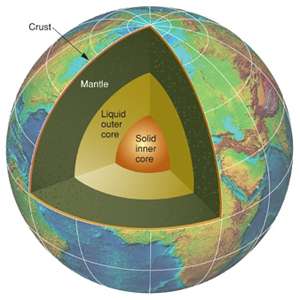Probing Question: What heats the earth's core?

Although we crust-dwellers walk on nice cool ground, underneath our feet the Earth is a pretty hot place. Enough heat emanates from the planet's interior to make 200 cups of piping hot coffee per hour for each of Earth's 6.2 billion inhabitants, says Chris Marone, Penn State professor of geosciences. At the very center, it is believed temperatures exceed 11,000 degrees Fahrenheit, hotter than the surface of the sun.
A cross-section of the Earth reveals three concentric layers. Around the outside, a thin, hard crust ranging from 10 to 100 kilometers thick. Under that, a donut-shaped mantle 2,900 kilometers thick. Instead of dough, it consists of viscous molten rock that flows very slowly, on a geological time scale. "It moves about as fast as your fingernails grow," Marone explains.
At the center of the Earth lies a two-part core. "The inner part is about the size of our moon," Marone says, "and has a density of essentially steel." The outer core surrounding it is an ocean of liquid metal 2,300 kilometers thick. The Earth's rotation makes this ocean flow and swirl, and the moving metal generates the planet's magnetic field.
Most of Earth's heat is stored in the mantle, Marone says, and there are four sources that keep it hot. First, there's the heat left over from when gravity first condensed a planet from the cloud of hot gases and particles in pre-Earth space. As the molten ball cooled, some 4 billion years ago, the outside hardened and formed a crust. The mantle is still cooling down.
"We don't think this original heat is a major part of the Earth's heat, though," Marone says. It only contributes 5 to 10 percent of the total, "about the same amount as gravitational heat."
To explain gravitational heat, Marone again evokes the image of the hot, freshly formed Earth, which was not of a consistent density. In a gravitational sorting process called differentiation, the denser, heavier parts were drawn to the center, and the less dense areas were displaced outwards. The friction created by this process generated considerable heat, which, like the original heat, still has not fully dissipated.
Then there's latent heat, Marone says. This type arises from the core's expanding as the Earth cools from the inside out. Just as freezing water turns to ice, that liquid metal is turning solid—and adding volume in the process. "The inner core is becoming larger by about a centimeter every thousand years," Marone says. The heat released by this expansion is seeping into the mantle.
For all this, however, Marone says, the vast majority of the heat in Earth's interior—up to 90 percent—is fueled by the decaying of radioactive isotopes like Potassium 40, Uranium 238, 235, and Thorium 232 contained within the mantle. These isotopes radiate heat as they shed excess energy and move toward stability. "The amount of heat caused by this radiation is almost the same as the total heat measured emanating from the Earth."
Radioactivity is present not only in the mantle, but in the rocks of Earth's crust. For example, Marone explains, a 1-kilogram block of granite on the surface emanates a tiny but measurable amount of heat (about as much as a .000000001 watt light bulb) through radioactive decay.
That may not seem like much. But considering the vastness of the mantle, it adds up, Marone says.
Sometime billions of years in the future, he predicts, the core and mantle could cool and solidify enough to meet the crust. If that happens, Earth will become a cold, dead planet like the moon.
Long before such an occurrence, however, the Sun will likely have evolved into a red-giant star, and grown large enough to engulf our fair planet. At that point, whatever heat is left in the mantle will hardly matter.
Source: Research/Penn State, By Joe Anuta















